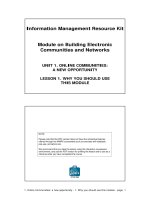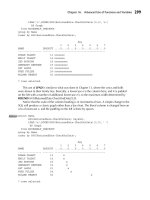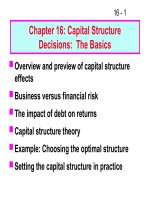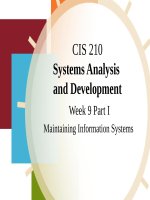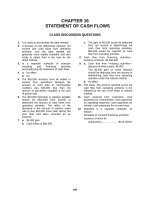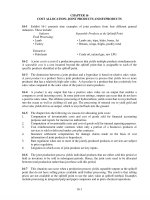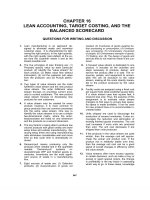macroeconomic mcgrowhill macro ch 16 19e use this one
Bạn đang xem bản rút gọn của tài liệu. Xem và tải ngay bản đầy đủ của tài liệu tại đây (230.51 KB, 32 trang )
16
Interest Rates and Monetary
Policy
McGraw-Hill/Irwin
Copyright © 2012 by The McGraw-Hill Companies, Inc. All rights reserved.
Chapter Objectives
• The equilibrium interest rate and
the market for money
• Monetary policy
• How the Fed controls the Federal
funds rate
• How monetary policy affects GDP
and the price level
• Effectiveness of monetary policy
and its shortcomings
33-2
Interest Rates
• The price paid for the use of money
• Many different interest rates
• Speak as if only one interest rate
• Determined by the money supply and
money demand
LO1
16-3
Demand for Money
• Why hold money?
• Transactions demand, Dt
• Determined by nominal GDP
• Independent of the interest rate
• Asset demand, Da
• Money as a store of value
• Varies inversely with the interest rate
• Total money demand, Dm
LO1
16-4
Rate of interest, i percent
Demand for Money
(a)
Transactions
demand for
money, Dt
(b)
Asset
demand for
money, Da
10
Sm
7.5
=5
+
5
2.5
0
Dt
50
100
Da
150
200
Amount of money
demanded
(billions of dollars)
LO1
(c)
Total
demand for
money, Dm
and supply
50
100
150
200
Amount of money
demanded
(billions of dollars)
Dm
50
100
150
200
250
300
Amount of money
demanded and supplied
(billions of dollars)
16-5
Interest Rates
• Equilibrium interest rate
• Changes with shifts in money supply
•
LO1
and money demand
Interest rates and bond prices
• Inversely related
• Bond pays fixed annual interest
payment
• Lower bond price will raise the interest
rate
16-6
Federal Reserve Balance Sheet
• Assets
• Securities
• Loans to commercial banks
• Liabilities
• Reserves of commercial banks
• Treasury deposits
• Federal Reserve Notes outstanding
LO2
16-7
Federal Reserve Balance Sheet
March 24, 2010 (in Millions)
Assets
Liabilities and Net Worth
Securities
Loans to Commercial
Banks
All Other Assets
$2,017,955
Total
$2,316,525
85,659
212,911
Reserves of Commercial
$ 1,147,747
Banks
150,087
Treasury Deposits
Federal Reserve Notes
893,035
(Outstanding)
125,656
All Other Liabilities and
Net Worth
$2,316,525
Total
Source: Federal Reserve Statistical Release, H.4.1, March 24, 2010,
LO2
16-8
Central Banks
LO2
16-9
Tools of Monetary Policy
• Open market operations
• Buying and selling of government
•
LO2
securities (or bonds)
• Commercial banks and the general
public
• Used to influence the money supply
When the Fed sells securities,
commercial bank reserves are reduced
16-10
Tools of Monetary Policy
• Fed buys bonds from commercial
banks
Federal Reserve Banks
Assets
Liabilities and Net Worth
+ Securities
+ Reserves of Commercial
Banks
(a) Securities
Assets
(b) Reserves
Commercial Banks
Liabilities and Net Worth
-Securities (a)
+Reserves (b)
LO2
16-11
Tools of Monetary Policy
• Fed sells bonds to commercial banks
Federal Reserve Banks
Assets
Liabilities and Net Worth
- Securities
- Reserves of Commercial
Banks
(a) Securities
Assets
(b) Reserves
Commercial Banks
Liabilities and Net Worth
+ Securities (a)
- Reserves (b)
LO2
16-12
Open Market Operations
• Fed buys $1,000 bond from a
commercial bank
New Reserves
$1000
Excess
Reserves
$5000
Bank System Lending
Total Increase in the Money Supply, ($5,000)
LO2
16-13
Open Market Operations
• Fed buys $1,000 bond from the
public
Check is Deposited
New Reserves
$1000
$800
Excess
Reserves
$4000
Bank System Lending
$200
Required
Reserves
$1000
Initial
Checkable
Deposit
Total Increase in the Money Supply, ($5000)
LO2
16-14
Tools of Monetary Policy
• The reserve ratio
• Changes the money multiplier
• The discount rate
• The Fed as lender of last resort
• Short term loans
• Term auction facility
• Introduced December 2007
• Banks bid for the right to borrow
reserves
LO2
16-15
The Reserve Ratio
Effects of Changes in the Reserve Ratio
LO2
(1)
Reserve
Ratio, %
(2)
Checkable
Deposits
(3)
Actual
Reserves
(4)
Required
Reserves
(5)
Excess
Reserves,
(3) –(4)
(6)
Money-Creating
Potential of
Single Bank, = (5)
(7)
Money-Creating
Potential of
Banking System
(1) 10
$20,000
$5000
$2000
$3000
$3000
$30,000
(2) 20
20,000
5000
4000
1000
1000
5000
(3) 25
20,000
5000
5000
0
0
0
(4) 30
20,000
5000
6000
-1000
-1000
-3333
16-16
Tools of Monetary Policy
• Open market operations are the most
•
•
•
LO2
important and frequently used
Reserve ratio last changed in 1992
Discount rate was a passive tool
Term auction facility is new
• Guaranteed amount lent by the Fed
• Anonymous
16-17
The Federal Funds Rate
• Rate charged by banks on overnight
•
•
•
•
LO3
loans
Targeted by the Federal Reserve
FOMC conducts open market
operations to achieve the target
Demand curve for Federal funds
Supply curve for Federal funds
16-18
Monetary Policy
• Expansionary monetary policy
• Economy faces a recession
• Lower target for Federal funds rate
• Fed buys securities
• Expanded money supply
• Downward pressure on other
interest rates
LO3
16-19
Monetary Policy
• Restrictive monetary policy
• Periods of rising inflation
• Increases Federal funds rate
• Increases money supply
• Increases other interest rates
LO3
16-20
Monetary Policy
10
8
Prime interest rate
Percent
6
4
2
Federal funds rate
0
1998
1999
2000
2001 2002
2003
2004
2005
2006
2007
2008
2009 2010
Year
16-21
Taylor Rule
• Rule of thumb for tracking actual
•
•
•
LO3
monetary policy
Fed has 2% target inflation rate
If real GDP = potential GDP and inflation
is 2%, then targeted Federal funds rate
is 4%
Target varies as inflation and real GDP
vary
16-22
Monetary Policy, Real GDP, Price
Level
• Affect on real GDP and price level
• Cause-effect chain
• Market for money
• Investment and the interest rate
• Investment and aggregate demand
• Real GDP and prices
• Expansionary monetary policy
• Restrictive monetary policy
LO4
16-23
(a)
The market
for money
Sm1
Sm2
Sm3
AS
P3
10
8
Dm
6
0
AD3
I=$25
AD2
I=$20
AD1
I=$15
P2
$125
$150
$175
Amount of money
demanded and
supplied
(billions of dollars)
LO4
(c)
Equilibrium real
GDP and the
Price level
(b)
Investment
demand
Price Level
Rate of Interest, i (Percent)
Monetary Policy and Equilibrium
GDP
ID
$15
$20
$25
Amount of investment
(billions of dollars)
Q1
Qf Q3
Real GDP
(billions of dollars)
16-24
Monetary Policy and Equilibrium GDP
(AS-AD Model)
(d)
Equilibrium real
GDP and the
Price level
(c)
Equilibrium real
GDP and the
Price level
AS
AS
Price Level
AD3
I=$25
AD2
I=$20
AD1
I=$15
P2
Q1
Qf Q3
Real GDP
(billions of dollars)
b
Price Level
P3
P3
LO4
c
P2
Q1
Qf Q3
a
AD3
I=$25
AD4
I=$22.5
AD2
I=$20
AD1
I=$15
Real GDP
(billions of dollars)
16-25


